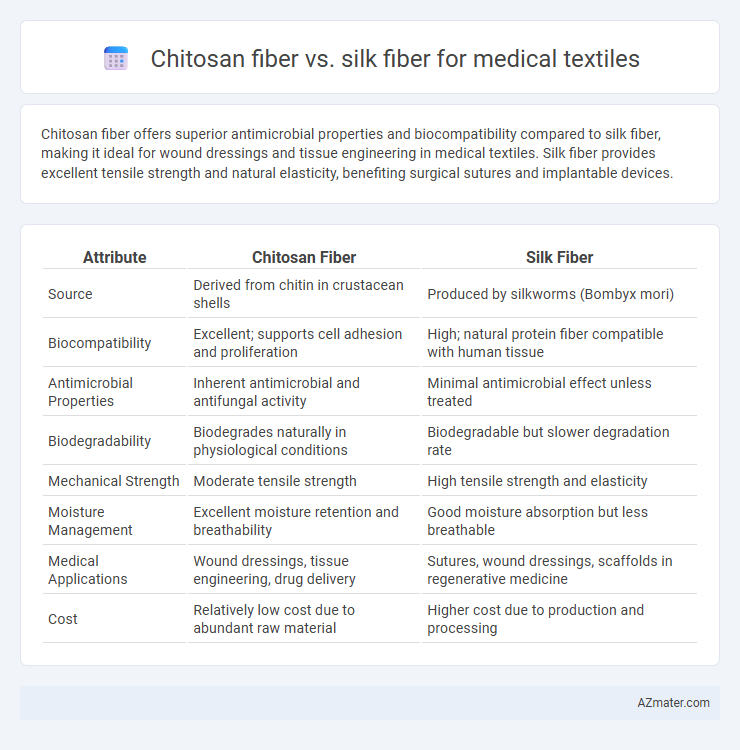Chitosan fiber offers superior antimicrobial properties and biocompatibility compared to silk fiber, making it ideal for wound dressings and tissue engineering in medical textiles. Silk fiber provides excellent tensile strength and natural elasticity, benefiting surgical sutures and implantable devices.
Table of Comparison
| Attribute | Chitosan Fiber | Silk Fiber |
|---|---|---|
| Source | Derived from chitin in crustacean shells | Produced by silkworms (Bombyx mori) |
| Biocompatibility | Excellent; supports cell adhesion and proliferation | High; natural protein fiber compatible with human tissue |
| Antimicrobial Properties | Inherent antimicrobial and antifungal activity | Minimal antimicrobial effect unless treated |
| Biodegradability | Biodegrades naturally in physiological conditions | Biodegradable but slower degradation rate |
| Mechanical Strength | Moderate tensile strength | High tensile strength and elasticity |
| Moisture Management | Excellent moisture retention and breathability | Good moisture absorption but less breathable |
| Medical Applications | Wound dressings, tissue engineering, drug delivery | Sutures, wound dressings, scaffolds in regenerative medicine |
| Cost | Relatively low cost due to abundant raw material | Higher cost due to production and processing |
Overview of Chitosan and Silk Fibers in Medical Textiles
Chitosan fiber, derived from chitin found in crustacean shells, offers exceptional biocompatibility, biodegradability, and inherent antimicrobial properties, making it highly suitable for wound dressings and tissue engineering in medical textiles. Silk fiber, produced by silkworms, is renowned for its remarkable tensile strength, excellent biocompatibility, and natural moisture-wicking ability, widely used in surgical sutures and advanced wound care products. Both fibers provide unique advantages in medical applications, with chitosan excelling in antimicrobial functions and silk maintaining mechanical robustness and comfort.
Chemical Composition and Structural Differences
Chitosan fiber, derived from chitin through deacetylation, consists primarily of b-(1-4)-linked D-glucosamine units, contributing to its biocompatibility and antimicrobial properties in medical textiles. Silk fiber, primarily composed of fibroin protein with repeating amino acid sequences rich in glycine, alanine, and serine, offers exceptional tensile strength and elasticity due to its highly ordered b-sheet crystalline structure. The chemical composition of chitosan imparts natural biodegradability and positive charge for wound healing applications, whereas the hierarchical fibrous structure of silk provides superior mechanical performance and cellular affinity in tissue engineering.
Biocompatibility and Cytotoxicity Comparison
Chitosan fiber exhibits superior biocompatibility and lower cytotoxicity compared to silk fiber, making it highly suitable for medical textile applications such as wound dressings and tissue engineering scaffolds. Its inherent antimicrobial properties and excellent cell affinity promote faster healing and reduced infection risk, whereas silk fibers, although biocompatible, may provoke mild immune responses in some cases. Extensive in vitro and in vivo studies confirm chitosan's enhanced safety profile, highlighting its advantage over silk in sensitive biomedical environments.
Mechanical Properties: Strength and Flexibility
Chitosan fiber exhibits high tensile strength and excellent flexibility, making it suitable for durable and adaptable medical textiles. Silk fiber, known for its superior biodegradability and smooth texture, also provides strong mechanical performance but with slightly less flexibility compared to chitosan. The choice between chitosan and silk fibers depends on the required balance of strength, flexibility, and biocompatibility for specific medical textile applications.
Antimicrobial Activity and Infection Control
Chitosan fiber exhibits superior antimicrobial activity compared to silk fiber due to its natural cationic properties that disrupt bacterial cell membranes and inhibit microbial growth. In medical textiles, chitosan fiber enhances infection control by providing a biocompatible, biodegradable barrier that reduces the risk of hospital-acquired infections. Silk fiber, while biocompatible and gentle on skin, lacks inherent antimicrobial properties, often requiring additional treatments to achieve similar infection control effectiveness.
Moisture Retention and Breathability
Chitosan fiber exhibits superior moisture retention due to its hydrophilic nature and ability to absorb and retain water molecules, making it highly suitable for medical textiles that require consistent hydration. Silk fiber, while naturally breathable and smooth, offers moderate moisture management but lacks the inherent antimicrobial and moisture-regulating properties found in chitosan. The enhanced breathability of silk supports comfort, but chitosan's unique bioactive characteristics provide additional benefits in wound healing and infection control within medical applications.
Biodegradability and Environmental Impact
Chitosan fiber exhibits superior biodegradability compared to silk fiber, breaking down more rapidly in natural environments due to its polysaccharide-based structure derived from chitin. Its environmental impact is lower, as chitosan is sourced from renewable marine waste, reducing reliance on animal farming associated with silk production. In medical textiles, chitosan fibers provide sustainable alternatives with enhanced biocompatibility while minimizing ecological footprint.
Processing and Fabrication Techniques
Chitosan fiber for medical textiles undergoes unique processing involving deacetylation of chitin, followed by wet spinning or electrospinning to produce biocompatible fibers with antimicrobial properties. Silk fiber fabrication relies on sericulture and degumming to extract fibroin, with subsequent filament or staple yarn formation through traditional spinning methods, ensuring high tensile strength and biocompatibility. Advanced techniques like nanofiber electrospinning for chitosan and recombinant silk protein processing enhance functionality and application specificity in wound dressings and tissue engineering scaffolds.
Clinical Applications: Wound Healing and Tissue Engineering
Chitosan fiber exhibits superior biocompatibility, antimicrobial properties, and hemostatic activity, making it highly effective for wound healing applications and accelerating tissue regeneration. Silk fiber offers excellent mechanical strength, biodegradability, and minimal immunogenic response, supporting scaffold formation in tissue engineering and skin grafts. Comparative studies highlight chitosan's enhanced ability to promote fibroblast proliferation while silk ensures structural integrity in long-term implantable medical textiles.
Future Prospects and Innovations in Medical Textiles
Chitosan fiber exhibits significant future potential in medical textiles due to its exceptional biocompatibility, antimicrobial properties, and biodegradability, making it ideal for wound dressings and tissue engineering applications. Innovations in nanotechnology and fiber blending are enhancing the mechanical strength and functionality of chitosan fibers, expanding their use in smart medical textiles for drug delivery and infection control. Conversely, silk fiber's natural strength, flexibility, and ability to support cell growth continue to drive advancements in sutures, scaffolds, and bioengineered implants, with research focusing on genetic modification and composite materials to improve performance and biocompatibility.

Infographic: Chitosan fiber vs Silk fiber for Medical textile
 azmater.com
azmater.com